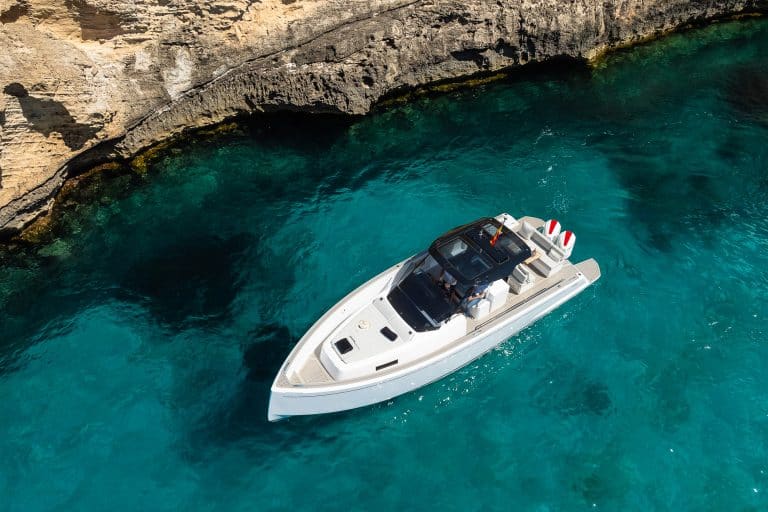From their diverse shapes and colours to their crucial role in maritime communication, discover the meaning of nautical flags. From Motyvel Group, we will analyse the different types, their interpretation, and the legal aspects surrounding them. Dive into this universal language of the sea and unveil the story behind each flag. At sea, each flag ensures maritime safety.
From childhood, the mere sight of a ship has filled us with excitement. In our favourite stories and films, the skull and bones signalled the arrival of pirates.
Although our first exposure to nautical flags comes from popular culture, not everyone fully understands the diversity of flags used in the maritime world and their profound meaning. These nautical flags, with their varied shapes, sizes, and colours, serve as a universal language in the maritime realm.
Motyvel Group, a company specialising in the world of navigation and the luxury boat market, will guide you through the rich history of nautical flags and their meanings. We will explore in detail the different types of flags, how to interpret their messages, and also analyse the legal aspects surrounding their use on vessels.
Nautical Flags: Types, Meaning, and How to Interpret Them
Nautical flags are an integral part of the maritime world. They often vary in shape, size, and colour, but their utility as a communication tool is universal. These flags can take the form of alphabet letters or numbers, and their combination can convey a wide range of messages. These symbols communicate valuable information between ships and ensure safety at sea. Below we will explain in detail their different types and how to interpret their messages.
Types of Nautical Flags
Nautical flags come in various shapes, sizes, and colours. Mostly, they are square, but you can also find hanging flags with a triangular and flat tip shape. There are 26 square flags representing the alphabet letters and 10 numbered pennants, along with a response pennant and three substitute flags.
On occasions, substitutes can be spotted, which are triangles, although they are less common. The only colours present in signal flags are black, blue, red, yellow, and white. These colours have been chosen for their high visibility, both at plain sight on the horizon and through binoculars.
The Dictionary of Nautical Flags
The use of different nautical flags is crucial for safety at sea, especially in situations where verbal communication might not be possible due to electronic equipment failures or radio issues.
An essential element to understand the meaning of nautical flags is the International Code of Signals (ICS). Each letter of the alphabet and each number has a flag equivalent, and each has a particular meaning:
A: Alpha – Diver down; keep clear
B: Bravo – Dangerous cargo
C: Charlie – Yes (affirmative)
D: Delta – Keep clear of me; I am manoeuvring with difficulty
E: Echo – Altering course to starboard
F: Foxtrot – I am disabled; communicate with me
G: Golf – I require a pilot
H: Hotel – Pilot on board
I: India – I am altering course to port
J: Juliet – Ship on fire; keep clear
K: Kilo – I wish to communicate with you
L: Lima – Stop your vessel immediately; I have something important to communicate
M: Mike – My vessel is stopped and making no way through the water
N: November – No (negative)
O: Oscar – Man overboard
P: Papa – In port: all onboard
Q: Quebec – Request free pratique
R: Romeo – Reversing course
S: Sierra – Engines are going astern
T: Tango – Keep clear; engaged in trawling
U: Uniform – You are running into danger
V: Victor – I require assistance
W: Whisky – I require medical assistance
X: X-ray – Stop your intention
Y: Yankee – I am dragging my anchor
Z: Zulu – I require a tug
Meaning and Combination of Flags
The meaning of nautical flags is not limited to individual letters; they can also be combined to convey more complex messages. Depending on the message, a ship can hoist one or several flags in sequence:
One flag: urgent or common signals.
Two flags: distress situations or manoeuvres.
Three flags: compass, relative bearings, standard times, verbs and punctuation, along with general coding and decoding signals.
Four flags: geographical signals, ship names, etc.
Five flags: ship’s time and position.
Six flags: cardinal points in latitude and longitude signals.
Seven flags: longitude signals containing more than 100 degrees.
This system allows sailors to communicate effectively in various situations and ensures safety at sea. For example:
The combination of flags D (Delta) and V (Victor) means “I am manoeuvring with difficulty and require assistance”.
Flags J (Juliet) and L (Lima) together indicate “I am in danger of grounding”.
The Secret Language of Flags
Although nautical flags are used for communication in all situations, sometimes secret languages with these flags are employed. For instance, the US Navy uses specific signals to communicate between ships. Similarly, NATO uses nautical flags along with some additional ones for warships or in short sets for unclassified messages.
In regattas, nautical flags take on specific meanings, either individually or in combination. For example, the P flag is used as “preparatory” and indicates an imminent start, while the S flag signals that the course has been shortened.
Legal Aspects of Nautical Flags
Nautical flags, as colourful and emblematic in the maritime environment, play a crucial role that goes beyond their mere decorative aspect. Despite the proliferation of onboard electronic navigation and communication equipment, nautical flags remain fundamental for safety and communication at sea. Moreover, maritime laws require certain standards regarding the use of nautical flags on vessels to be met.
One of the most significant legal elements associated with nautical flags is the regulation of their use. Various countries have specific regulations governing when and how these flags can be hoisted on vessels registered under their jurisdiction. Here, the role of the country’s national flag becomes significant. It’s important to remember that in national waters, each vessel must hoist the national flag of its country of origin, and this must be clearly visible. In Spain, Royal Decree 2335/1980, of 10 October, clearly states that all vessels and floating devices, regardless of their type or activity, must exclusively fly the Spanish flag. Flags of the autonomous communities can also be hoisted alongside the national flag, provided they are smaller in size. In most cases, the autonomous community flag should not exceed one-third the size of the national flag.
Countries, including Spain, adhere to international conventions and treaties related to maritime navigation. One of the most notable is the United Nations Convention on the Law of the Sea. This convention establishes that vessels must sail under the flag of a single State and will be subject to the exclusive jurisdiction of that State on the high seas.
Failing to comply with regulations related to the use of nautical flags can result in legal sanctions. Vessel owners must be aware of the relevant regulations in their jurisdiction and ensure they strictly adhere to them. Non-compliance can result in penalties ranging from fines to the immobilisation of the vessel.
Nautical flags are much more than colourful adornments on ships; they are a universal language allowing sailors to communicate effectively and swiftly at sea. Understanding their meaning and how to








